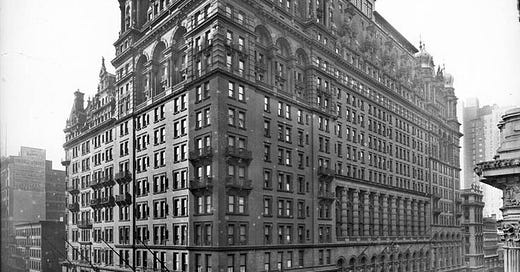Manhattan Hotel Futurism
“The model of the hotel undergoes a conceptual overhaul and is invested with a new experimental ambition that creates Manhattan's definitive unit of habitation, the Residential Hotel—place where the inhabitant is his own houseguest, instrument that liberates its occupants for total involvement in the rituals of metropolitan life.”
-Rem Koolhaas, Delirious New York
Cities face an existential crisis that grows more severe all the time: With so many traditional urban activities transposed to digital space, and with the physical world increasingly downstream of the internet, our collective idea of what a city actually is doesn’t seem to keep up with the reality. In many ways, we remain stuck on a warm memory of the 20th-century city, LARPing an urban existence that largely persists in our imaginations. A half century ago, Marshall McLuhan could already announce that “the city no longer exists except as a cultural ghost for tourists.” Since then, as he predicted, mass media has found increasingly sophisticated ways to transmit urban culture everywhere, decoupling it from its physical sources.

From my vantage point in New York (and yes, I’m annoyingly using New York as shorthand for a broader version of urban culture), this existential crisis manifests as an acute nostalgia for bygone eras that (supposedly) coincided with more authentic forms of city life: the gritty ‘70s, the sparkling pre-9/11 Sex and the City years, and now even ‘00s Williamsburg indie sleaze, which feels like it barely ended before returning (maybe the cutoff for our ability to mine the past in this way is the subsequent decade, when everyone was staring at their phones all the time). Because this nostalgia is so powerful, and because catering to it is so lucrative, cities preserve commercial and cultural patterns that have become outmoded but remain appealing, thereby restraining the impact of emergent forces like Amazon.
What does the actual city of the future look like? To put on a cynical hat and momentarily set aside concerns like climate change and social cohesion (something many are happy to do), it would probably look more like the suburbs, where there is less inertia holding the past in place and less reason not to embrace the technological state of the art, or whatever version of that one can afford.
In places like New York, meanwhile, we seem at least as concerned with hanging on to the past—which nonetheless constantly threatens to slip away.
These conditions are the opposite of what Rem Koolhaas declares in his 1994 book Delirious New York:
“In Manhattan the new and revolutionary is presented, always, in the false light of familiarity.”
Koolhaas is describing the late-19th century construction of the Waldorf-Astoria hotel and the new kinds of urban life that it made possible (a topic I’ll come back to); today, in Manhattan and everywhere else, we seem to present the familiar in the false light of novelty, rather than the reverse.
Or do we?



